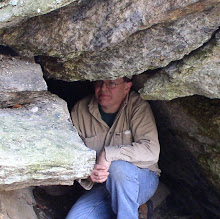This trip was dedicated (or suppose to be) to Rhode Island. However, more and more in recent times, I've learned a valuable lesson: do not rely on conditions being favorable for kayaking.
The first day started pretty much as planned, dropping into the Massachusetts side of Wallum Lake. First on the list was to scout out a "snake ledge" first showed to me years ago by an employee at the Douglas State Forest. This area encompasses some of the territory covered in the old book "The Wallum Pond Estates", a subject I've revisited time and again over the years.
A bit of hiking eventually brought me to the supposed site of the snake ledge. Closer inspection showed it to be an old granite quarry. Indeed, further exploration in the area turned up a number of these old quarrying sites. Conditions on the Lake proved too windy, so I thought I'd move to the southern end (in Rhode Island) where a small put-in would allow me to access that end. It was here I expected to find Patitents (sic) Rock from an old postcard. There are several postcards (including a corrected spelling) showing this same rock. But wind conditions at the southern end were even worse than at the northern.
So I took to the road, a bit farther, hitting Forger's (one of many names for this cave) Cave before spending the night in the area. Early morning brought favorable conditions to go out and explore Wallum Lake. A multitude of erattics lined the shore as well as its bottom. Patitents Rock was located, the lake fully explored, and I moved on to the Newport area.
Next morning brought disappointment in small craft advisories out on the ocean. So the time was filled visiting an old favorite, Purgatory, exploring Third Beach, then doing a significant portion of the Cliff Walk (something only slightly looked at in the past) while being buffeted by heavy winds coming off the ocean. The afternoon saw Pirates Caves and a close up of the geologic makeup of the area. Although it is primarily know for its colorful shale, there is limestone present.
Rains were forecast to move into coastal areas on the fourth day, so I decided to pull the plug on this trip to Newport a day earlier than planned. I headed inland to southwestern Worcester County (Massachusetts) for my first ever look at some Indian caves. This hillside is primarily broken talus that could take the better part of the day to explore. A number of large erratics, balanced/perched boulders, and a modest sized overhang are also present. At present, I'll be looking over my information and correlate it with that already existing, to see exactly which are considered the Indian Cave(s).












